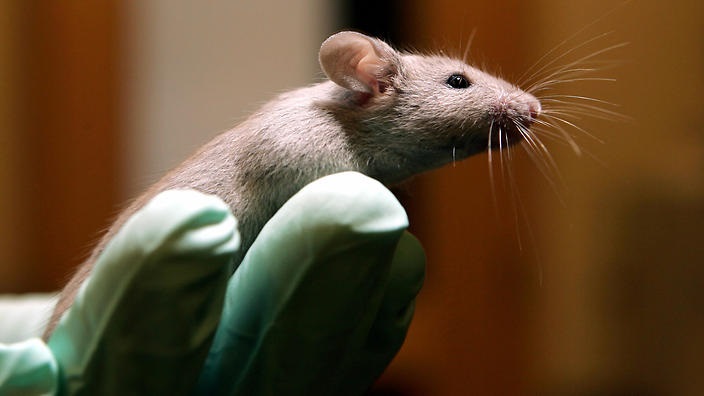Significant improvements in Ebola research have been made possible by researchers at the University of North Carolina. The researchers have not only bred a mouse that can be used to better investigate the way Ebola symptoms develop in a human host, but have also identified several key genes that account for a variety of Ebola symptoms–in particular one gene, Tek, which accounts for a large amount of the symptom variation in individuals within a species.
“Laboratory mice have traditionally been unable to be infected by wild-type Ebola virus,” Martin Ferris, research assistant professor of genetics at UNC-Chapel Hill and one of the researchers on the project, told The Speaker.

Typical lab mice do not develop Ebola in the way that humans do–mice infected with Ebola don’t develop the fatal symptoms that present in human victims. The team considered, however, that some mice might be more susceptible than others, and bred a new mouse strain that could be infected with an Ebola virus and which displayed symptoms like those displayed by human Ebola victims.
“A mouse adapted strain of Ebola has been used for in vivo studies of Ebola pathogenesis for over 15 years,” said Ferris. “This mouse adapted Ebola virus was used in our studies.” Ferris clarified for us that the team did not infect mice with the active human strain of Ebola that is currently epidemic in West Africa. Nevertheless, strict medical precautions were taken.
“In general, adaptation of viruses to small animal models results in attenuated viruses as measured on human cell types–obviously there are no studies showing primary human infection. Often this is due to viral changes to utilize host-species specific cell receptors. That said, it is not clear whether the mouse adapted Ebola virus used in these studies would cause disease in a human. Therefore, to be safe, this virus was still handled under Biosafety Level 4 conditions, just like other Ebola virus strains.”
The team bred together eight genetic mouse variants to create the new strain that could be infected and develop symptoms similar to those experienced by humans.
Ferris elaborated on how the process worked.
“Just as host genetic variants can impact disease susceptibility, so too can viral genetic variants. In other words, just as there is no single human from a genetic standpoint, there is no single Ebola virus from a genetic standpoint.
“In some cases specific mutations in a virus can be identified and characterized which allow for improved infection of a different species (e.g. mice instead of humans). In other cases, there are only associations of sequence variants in different stages of an epidemic. For example, as viruses that have typically resided in wild animal populations spend more and more time spreading within the human population, and eventually are maintained by human to human contact, we can see genetic variants selected for in the virus population. This is illustrated by the SARS-coronavirus epidemic in 2002-2003, where changes in the virus over the course of the outbreak allowed it to interact more efficiently with its receptor on human cells. This likely allowed the virus to infect humans more efficiently, thereby worsening the outbreak.”
The UNC study will aid researchers in fighting Ebola by providing them with a better tool for understanding how Ebola Ebola infection manifests in the body of a host, and by pointing to a gene that researchers can target in their investigations.
The team found that a combination of genes was involved in producing a range of disease symptoms, and linked genetic variation to symptom variety. Not only that: the researchers were able to identify a single gene that accounted for much of the variation in symptoms–a gene that codes for the protein Tek.
“Our study not only in gives an improved mouse model which recapitulates more of the severe Ebola disease seen in humans,” said Ferris, “but also in pointing to a gene, Tek, which has sequence variants that are strongly associated with disease outcome in these mice. This helps in two ways.
“Therapeutics and vaccines need to be shown to be both effective against viral infection, and also safe for individuals. By developing a mouse model that shows many aspects of severe Ebola disease, we have a better platform for quickly assessing how effective treatments might be.”
“We now have a genetic target (Tek),” continued Ferris, “and its associated pathway of host response genes where we can focus studies on. Having a specific pathway that differentiates resistant and susceptible mouse lines provides us with a good host pathway that can be targeted to develop Ebola virus therapies.”
Of particular importance is the way that a disease, such as Ebola, infects individuals within a species differently, and that means variants in a species genetic code need to be identified in order to combat the disease–exactly what was accomplished in the research.
“Host genes have a major impact on susceptibility to infection, and not just between species,” said Ferris. “The mice we used were related to each other, yet some were resistant to infection and others got hemorrhage in a very controlled experiment. This means variants in their genes played a major role in determining their disease outcomes.”
 The UNC team has been working on the study since before Ebola made headlines earlier this year, and Ferris pointed out that disease, if it is to be successfully fought, must be studied before it becomes a problem.
The UNC team has been working on the study since before Ebola made headlines earlier this year, and Ferris pointed out that disease, if it is to be successfully fought, must be studied before it becomes a problem.
“I think another critical point is that we cannot wait for a major outbreak to start research on potential human pathogens,” said Ferris. “We have been part of this collaborative study for over 2 years, and therefore started well before the current outbreak. Only by identifying pathogens and studying them before they cause pandemics can we hope to develop the tools needed to combat infection.”
The report, “Host genetic diversity enables Ebola hemorrhagic fever pathogenesis and resistance,” was authored by Angela L. Rasmussen, Atsushi Okumura, Martin T. Ferris, Richard Green, Friederike Feldmann, Sara M. Kelly, Dana P. Scott, David Safronetz, Elaine Haddock, Rachel LaCasse, Matthew J. Thomas, Pavel Sova, Victoria S. Carter, Jeffrey M. Weiss, Darla R. Miller, Ginger D. Shaw, Marcus J. Korth, Mark T. Heise, Ralph S. Baric, Fernando Pardo Manuel de Villena, Heinz Feldmann, and Michael G. Katze, and was published in Science Magazine.
By Dan Jackson
